If the tool is being replaced due to breakdown or wear, there is usually no need to evaluate what tool to specify for its replacement. It’s a simply question of finding a direct replacement or backup tool of the same type and torque capacity.
However, if the torque specification or tightening strategy changes, it’s prudent to determine whether the new requirements justify a new fastening system. In that event, engineers should consider the following questions:
- Can the current tool handle the new requirements?
- What are the torque or angle tolerances? Is statistical process control required?
- Has the existing process been troublesome? Have there been frequent breakdowns or operator complaints about excessive weight, noise, torque reaction or difficulties with maneuverability?
- Is the fastening workstation a bottleneck? Is there enough cycle time? Would a multispindle power head improve productivity?
- Is it a good opportunity to re-evaluate the assembly process? Can non-value-added tasks, such as click-wrenching, be eliminated by using a fastening system with closed-loop feedback? Would this save an operator?
- Should we include a visible indication that the process was completed successfully? Do we need a label printer, paint marker or data acquisition system?
- What are the warranty costs on this assembly? Can we reduce them by improving the fastening process?
- Should we look at different types of assembly tools?
- Does the tool now require fixturing due to high torque requirements? Will ergonomics be compromised?
- Have the sockets or accessories changed? Are they available?
- How will the new fastening system affect the power supply? Is a larger air line required? Will it cause fluctuations in electrical power?
- Is the new fastening specification accompanied by a change in the parts or fasteners? Will this cause increased friction or galling?
- Will the change affect how the process is audited? Will new measurement equipment be required?
- Will spare parts be available?
- Will the supplier offer service and support?
- Do the operators need training?
- What procedures should be followed if an assembly is rejected? How will the rejects be tagged?
- What are we trying to achieve? How will we measure success or failure?


